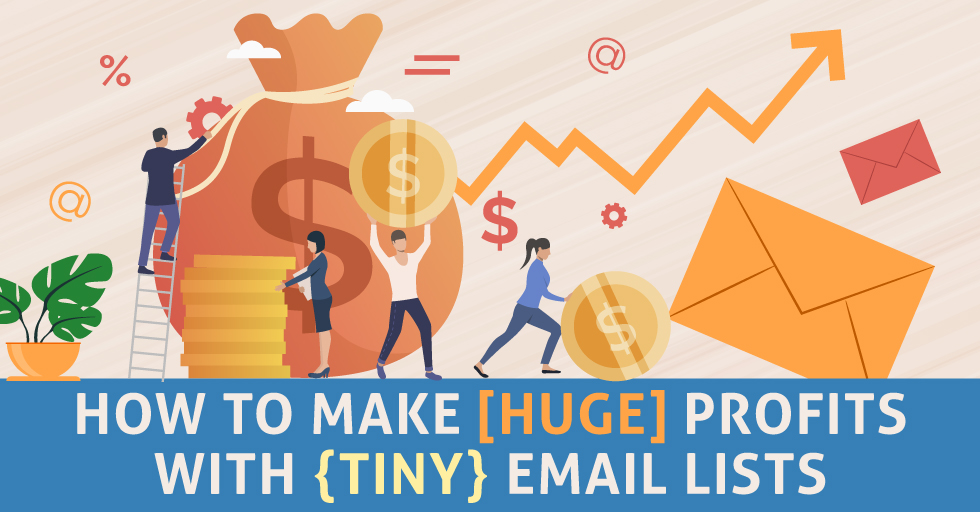 Recently, I purchased some stuff on Amazon. Days later, I got an e-mail from them inviting me to check out other products that might also interest me.
Recently, I purchased some stuff on Amazon. Days later, I got an e-mail from them inviting me to check out other products that might also interest me.
Now, say I’m a first-time Amazon customer. How would they get me back to buy more? Social media? Google banner ads? Something on Tik Tok? Maybe, but their message would likely be lost among the myriad of daily posts, distractions, cat videos, etc. With the proper privacy settings, I can also block out many ads.
If you thought e-mail marketing was dead, you’re mistaken. If Amazon is still sending targeted customer e-mails, it can only mean they’re still earning tons of money from it.
Yes, e-mail marketing is still strong and thriving. It will continue to thrive, because it’s always been one of the most personal and familiar forms of communication. It’s a form of communication that goes across the entire spectrum of online marketing. Everybody has email. This isn’t to diminish from other marketing methods, but except in rare cases, email will outperform every other marketing strategy over the long term.
Sure, you can argue that email is getting more and more cluttered… so is everything else. Yes, people have shorter attention spans. However, the challenge is not making sure your email is delivered to your customer. It’s about catching their attention and them wanting to open your message.
So how do you do that? Keep reading to learn my methods and tips to email marketing, and how you can make huge profits with even a small list.
Create Relationships
For those trying e-mail marketing for the first time, don’t expect immediate sales after one campaign.
The first step is to modify or change your mindset. In my podcast on this topic, I discussed that any marketing endeavor should have this goal – to create or build relationships.
It’s just like dating. Your prospects have to first get to know you better before buying. You also need to get to know them to offer the right product. You need to find out their pain points and their wants.

Only 15 percent of people who enquire about a product would buy it in the first 90 days. The rest, 85 percent, will wait for more than 90 days before purchasing.
Therefore, it will take several e-mails to win over prospects and convert them to customers. And once a sale is made, it shouldn’t end there. You’re after a long-term relationship, and one highly effective way to nurture this is by e-mail.
I often compose e-mails that are informal and personalized. It’s not just the use of the person’s first name. I address a particular need or concern.
I keep them short and simple. I avoid the fluff and stick to the facts. Most importantly, it’s always about the recipient. If you want to build a relationship, keep this in mind.
Lastly, be authentic, whether you’re making a statement or asking a question. People can detect fakes. They know spam e-mail when they see one.
Respect Your Recipients’ Attention
People are interested in e-mails that are relevant to them. Remember as well that the reverse is true. If the first one or two are not relevant, they will likely ignore your emails when they see future messages from you, even if they happen to be relevant.
Focus on your target market. Sending a mass e-mail to 10,000 recipients without knowing what they want will likely get you almost no response. You may be e-mailing the wrong people in the first place.
When you’re building your list, you already know what your customer is interested in… otherwise they wouldn’t have signed up for your emails in the first place. If you have a blog on gardening, send them only information on gardening. Depending on the email service you use, you can even tag those customers that open or click certain emails. So, if you send information on garden tools, landscaping and tomato gardening, you can begin to segment those customers that are individually interested on different topics. Then, for those who interacted mainly with landscaping in past emails, send a specific email just on landscaping information in the future.
Another great strategy is to simply ask people if something is of interest to them. If you are having a new promotion or contest, ask your subscribers to click the link to enter. Certain people will click, while most won’t. But for those who do, they are definitely interested in what you have to offer, and your open rate, interaction and sales on this campaign will be extremely high.
This way, even with a tiny list, your posts are engaging and much more profitable, as you send targeted and engaged subscribers information that is highly relevant to them.
It’s Not the Medium But the Message
What’s in it for your audience? This is the only question you should answer.
Often, e-mail marketers focus on the possible sales generated by their e-mail campaigns. This becomes the driving force while they compose their message. They’re discouraged by the results when these are below expectations.
This makes them think e-mail marketing isn’t worth the effort or is obsolete.
But, if you are motivated to provide true value for your audience, the result is the opposite. A carefully written e-mail with your recipient’s needs in mind will go a long way towards achieving success.
Create a Narrative as Part of Your Campaign
Every good marketer knows that storytelling is one of the best ways of keeping your recipients engaged. Stories create connections and evoke emotions. This also builds relationships with customers.
You can tell a story through a single email or several e-mails. A narrative of how you got into the business and why you developed your product is an excellent way of introducing yourself to new prospects.
 Like a mini-series, you can share your story over several short e-mails. You could begin with your experiences and follow them up with those of others. Customers relate to these and leaves them wanting more. Think of a good Netflix series or even a soap opera. They always hook you on a cliffhanger, and you can apply this to email.
Like a mini-series, you can share your story over several short e-mails. You could begin with your experiences and follow them up with those of others. Customers relate to these and leaves them wanting more. Think of a good Netflix series or even a soap opera. They always hook you on a cliffhanger, and you can apply this to email.
Or, you could start with a teaser of a product you’ll launch soon, focusing on solving a problem or answering a need. Whatever you decide, it’s always about the value you can offer your audience, and the promise of something more.
Always Include a Call to Action
You always want your audience to take some sort of action while or after reading your e-mail. It could be for them to click a link or stay tuned for your next message. It doesn’t always have to be to buy something (in fact, it usually isn’t), but you need to ask them to perform some sort of action. This does two things:
- It trains your subscribers to expect you to ask them to do something.
- It increases your engagement, as you are asking them to do something rather than just relying on them to passively read your message.
The action you ask them to perform can be a link where they can interact further with you, ask a question, read a blog post, watch a video, go to one of your social pages, or to sign up for or buy something.
How to Deal with Non-responders?
With tracking apps, you get to know who’s not opening your e-mails. Don’t give up on these people yet. Launch a re-engagement campaign.
Here’s a subject line you can use – “We like to hear from you!” In your body, you can add that if they don’t reply within a week, for instance, you’ll delete them from your list. (So they would not deal with an unwanted e-mail).
Of course, you don’t have to do that. Just exclude them from your future marketing efforts. When you have time, sort through and determine whether these addresses are worth keeping.
I would also ask recipients if they prefer other ways of communication. They might give you their cell phone number for SMS or social media account name instead. If they interact with you, this means they are still engaged and interested.
Keep it Short and Simple
A short subject, phrase or a single sentence in your e-mail’s body may be enough to capture what your audience values. Some of the great subjects I’ve seen are:
- “Uh-oh, your prescription is expiring” (Warby Parker/prescription glasses)
You could replace the word “prescription” with “subscription” for instance. It depends on your business type.
- “Here’s that discount you wanted.” (Lamoda /women’s footwear)
It’s straight to the point. Everyone loves a discount from their favorite shops.
- “What did you think? Write a review.” (REI/Outdoor equipment retailer)
This is great for new customers. Keep them engaged even after a sale. Also, you could use their reviews to promote your business. (With their permission, of course)
Your body could be one sentence. Often, a question works well, such as:
- Are you still looking to buy a house in Ohio?
- Are you still looking for these garden planters?
- Are you still looking to grow your online subscribers?
- Do you still want that vacation in the Caribbean?
Go Through the Process

There’s no shortcut from prospects becoming aware of your product or company, to engaging with you, and finally to a paid conversion. Nurture your email list, no mater how small, and motivate your subscribers to engage with you. In doing so, you build a strong relationship that will be profitable (for you and your customer) and last long-term.
The strategies and ideas are ones I’ve used for years with my email lists and subscribers, and it’s added a lot of money to our businesses. If you have not tried email (or you have in the past and didn’t see results), I would definitely suggest you try again with these points in mind.
To watch or listen to the complete podcast on this process, please click here, or download the transcription below:
Other recent episodes of The Growth Booth:
Episode 13 – Lifestyle Design, Part 2: A Framework For Happiness

Designing a lifestyle you love is the key to happiness, but how do you do it? Is there a “recipe” for happiness and lifestyle freedom? Is there a “rinse and repeat” framework for this?
Episode 15 – 10 Power-Packed Copywriting Strategies to Boost Conversions

Is there a formula for writing hypnotic sales copy? And can simple tweaks to your messaging rapidly grow your profits?
Episode 16 – An Unconventional Framework For Success

They say “success leaves clues” but what are the clues? And what are the variables that dictate your bottom line in business?
or, click here to a listen to the full show.
For these and upcoming podcasts visit Thegrowthbooth.com where we talk about online business, mindset, and lifestyle freedom.
Episodes are released every Tuesday on these popular channels:






Thanks for these tips, I’m just starting an email list for my ecom business. Always love your posts, and just started listing to your podcast.
Thanks, Christian, email is one of the strongest factors in the success of our businesses.